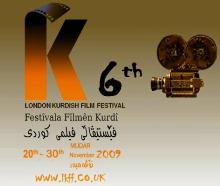25/11/2009

The latest film by Hiner Saleem, ‘After the Downfall’ was shown as part of the 6th Kurdish Film Festival held in London this week. Featuring Nazmi Kirik as a Kurdish exile in Germany the film captures the lives of a group of Kurdish friends and family celebrating the downfall of Saddam Hussein. The atmosphere of liberation and joyous delirium is soon overshadowed by a revelation that divides the group of friends and family members and is interspersed with a gradual building of tension between the conflicting political sides in Iraq represented at the gathering.
Cleverly intertwined throughout are the lives of Kurds currently in Iraq as well as the legacy of the Kurdish nation; this is achieved by continuous documentary and news footage of the fall of the regime in Iraq projected onto a wall. This adds a second dimension to the film in which the viewer cannot separate the Kurds in the diaspora from those in the homeland; their celebration and pain through remembrance is shared. As well as blending geographical locations Saleem also succeeds in linking together time periods with projections of the violence Saddam Hussein’s Anfal campaign contrasted with the increasing violence of the evening in Germany.
 The film was met with mixed reviews during the Film Festival. Kurdish viewers questioned the necessity of a sex scene early on in the film as well as the alcohol-fuelled sense of chaos; indicative of the current trend amongst Kurdish filmmakers from the US and Europe to portray Kurds as liberal and secular.
The film was met with mixed reviews during the Film Festival. Kurdish viewers questioned the necessity of a sex scene early on in the film as well as the alcohol-fuelled sense of chaos; indicative of the current trend amongst Kurdish filmmakers from the US and Europe to portray Kurds as liberal and secular.
It is in the presentation of the simplistic formula that US-led intervention and the downfall of Saddam led to Kurdish freedom that the film should be held up to scrutiny. If viewing ‘After the Downfall’ with little background knowledge about the Kurdish situation one would be forgiven for believing that the only enemy of the Kurdish people was Saddam Hussein and that everyone can now live happily ever after in a liberated Kurdistan.
In fact, as many Kurdish viewers were keen to point out, the Kurds of the modern day states of Iraq, Iran. Syria and Turkey have faced a long struggle for recognition, statehood and freedom. In presenting the Kurds here merely as recipients of US-led action to secure their freedom rather than showing the sacrificial and determined efforts Kurds have taken against their oppressors the film fulfils Western misconceptions about the Kurdish region and the events of 2003.
The decision by the London Kurdish Film Festival Organising Committee to show ‘After the Downfall’ following the short film ‘Cheese- Hope Dies Last’ was a poignant reminder of the ease at which the onlooker can view footage of war and destruction and neatly forget those caught beneath the fighting. Literally in this case. Directed by Huseyin Tabak the documentary style film allows the viewer access into the lives of a family trapped in the cellar of their collapsed house, and brings moments of humour and light-heartedness followed by tragedy. The powerful impact of this film was heightened given the context of the continuous footage of the destruction of Baghdad during ‘After the Downfall’.
The annual London Kurdish Film Festival provides an opportunity to celebrate the strength and resilience of Kurds worldwide and more importantly for a people without a land to present their reality in all its beauty and joy, flaws and tragedy to the world. It is therefore essential that the Kurdish Film Festival and the films it shows must be led, owned, debated and scrutinised by a Kurdish agenda. If Kurdish filmmakers start bowing to Western suppositions and political agendas regarding the Middle East then not only will Kurdish film suffer but an invaluable opportunity for representation on the world stage will be lost.